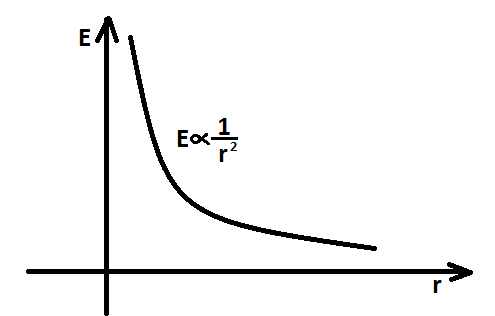
The intensity of electric field E due to charge Q at distance r.
A.$E \propto r$
B.$E \propto \dfrac{1}{{{r^2}}}$
C.$E \propto \dfrac{1}{r}$
D.$E \propto \dfrac{1}{{{r^3}}}$
Answer
510k+ views
Hint: In this question we use electric potential i.e. at a point is defined as the amount of work done in bringing a unit positive charge from infinity to that point. Unit of potential is $1V = 1\dfrac{J}{C}$,
$V\dfrac{W}{Q}$ , and we will also use Coulomb’s Law.
Formula used: $E = k\dfrac{Q}{{{r^2}}}$
Complete answer:
The power of the electric field is the force unit charge. It is the intensity at a particular point where it applies force on the charge when we put a charge.
For example, if E is the electrical field created at point P by a charge Q located at r distance from charge Q, let's now place a charge q at point P. Then, we observe force experienced by charge $F = qE$
Hence, from Coulomb’s Law:
$E = k\dfrac{Q}{{{r^2}}}$
Where E is an electric field, q is charged at a distance r and k is a constant. Therefore,
$E \propto \dfrac{1}{{{r^2}}}$
The graph between the electric field and the distance r will be parabolic which is shown below,

Hence option (B) is the correct answer.
Additional information:
The electric field and the electrostatic force can be related with a formula which states that the electric field due to a unit electric positive charge at a given point is equal to the electrostatic force divided by the charge, this can be written mathematically as follows,
$E = \dfrac{F}{q}$, where $E = $electric field, $F = $electrostatic force, $q = $charge.
The electric field intensity at a point is the force experienced by a unit charge placed at that point, and Electric field intensity is a vector quantity.
Note:
In this question we have used the Coulomb’s Law: So, it states that the magnitude of the electrostatic force of attraction or repulsion between two-point loads is directly proportional to the sum of the magnitudes of loads and inversely proportional to the square of the distance between them. The Force joins them along the straight line. The electrostatic force between them is repulsive if the two charges have the same sign; if they have different signs, the force between them is attractive.
$V\dfrac{W}{Q}$ , and we will also use Coulomb’s Law.
Formula used: $E = k\dfrac{Q}{{{r^2}}}$
Complete answer:
The power of the electric field is the force unit charge. It is the intensity at a particular point where it applies force on the charge when we put a charge.
For example, if E is the electrical field created at point P by a charge Q located at r distance from charge Q, let's now place a charge q at point P. Then, we observe force experienced by charge $F = qE$
Hence, from Coulomb’s Law:
$E = k\dfrac{Q}{{{r^2}}}$
Where E is an electric field, q is charged at a distance r and k is a constant. Therefore,
$E \propto \dfrac{1}{{{r^2}}}$
The graph between the electric field and the distance r will be parabolic which is shown below,

Hence option (B) is the correct answer.
Additional information:
The electric field and the electrostatic force can be related with a formula which states that the electric field due to a unit electric positive charge at a given point is equal to the electrostatic force divided by the charge, this can be written mathematically as follows,
$E = \dfrac{F}{q}$, where $E = $electric field, $F = $electrostatic force, $q = $charge.
The electric field intensity at a point is the force experienced by a unit charge placed at that point, and Electric field intensity is a vector quantity.
Note:
In this question we have used the Coulomb’s Law: So, it states that the magnitude of the electrostatic force of attraction or repulsion between two-point loads is directly proportional to the sum of the magnitudes of loads and inversely proportional to the square of the distance between them. The Force joins them along the straight line. The electrostatic force between them is repulsive if the two charges have the same sign; if they have different signs, the force between them is attractive.
Recently Updated Pages
NCERT Solutions For Class 1 English Marigold (Poem) - One Little Kitten

NCERT Solutions For Class 1 English Marigold (Poem) - A Kite

NCERT Solutions For Class 11 English Woven Words - The Lament

NCERT Solutions For Class 12 Chemistry In Hindi - Chemistry In Everyday Life

NCERT Solutions For Class 12 Maths In Hindi - Differential Equations

NCERT Solutions For Class 11 Physics In Hindi - Thermal Properties of Matter

Trending doubts
1 ton equals to A 100 kg B 1000 kg C 10 kg D 10000 class 11 physics CBSE

Difference Between Prokaryotic Cells and Eukaryotic Cells

One Metric ton is equal to kg A 10000 B 1000 C 100 class 11 physics CBSE

1 Quintal is equal to a 110 kg b 10 kg c 100kg d 1000 class 11 physics CBSE

Proton was discovered by A Thomson B Rutherford C Chadwick class 11 chemistry CBSE

Draw a diagram of nephron and explain its structur class 11 biology CBSE




